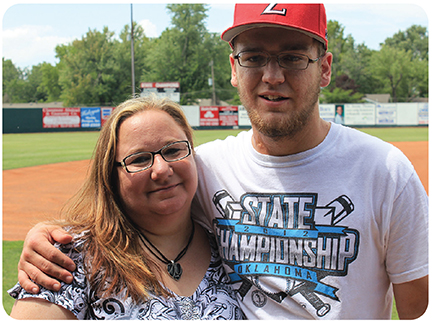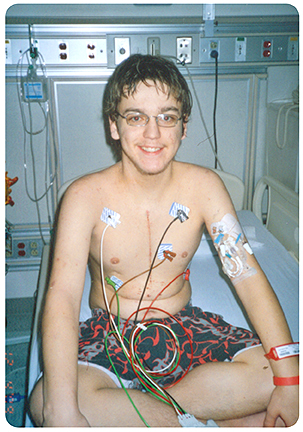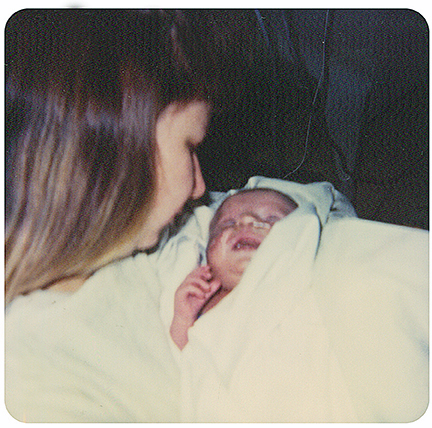Tell Us Your Story
 Brady - Claremore, Oklahoma
Brady - Claremore, Oklahoma
This is the story of a 15-year-old whose life was changed by a determined family, dedicated surgeons, a World Series Most Valuable Player and SoonerCare.
When Brady Wells was born, his doctors and parents knew he had a severe heart problem. His mother, Valerie Wells, said there were “83 rollercoaster days” of not knowing whether her son would survive and be able to come home.
The left ventricle of Brady’s heart was misshapen and the medical staff used a “push/pull” procedure to correct the problem, Wells said. “They thought it was just his lungs,” she said. “But after some tests, they figured out his problem was more about his heart than his lungs.”
As medical problems mounted, so did expenses. Brady was going to need round-the-clock care even after he went home. Wells had to leave her job as a nurse to care for her son.
“I had insurance at the time,” she said, “but I was unable to work due to his illness, so he went on SoonerCare.”
She said Brady was on medication for about seven years and was delayed in starting school for a year. By then, doctors thought Brady had improved. “We went to yearly appointments after he was about 7 years old and thought everything was fine,” she said.
In the summer of 2009, after being off of medication for several years, 15-year-old Brady was attending school and playing baseball – his passion.
Brady had allergies and asthma, Wells said, but otherwise he seemed to be doing well. He went for yearly checkups with his doctor, had routine visits with his allergy doctor and went every three months to see an asthma specialist.
“He loved baseball,” Wells said, “and he played baseball a lot. He was on tons of asthma meds, but Brady only had to use his (asthma) inhaler once, in all the years, he played baseball.”
At the end of June, Brady finished his baseball season then in mid-July had a routine visit to his allergy doctor.
 The checkup turned out to be anything but routine. X-rays showed Brady’s heart was very enlarged. His allergy doctor said he had no idea how Brady could play baseball; his body was getting very little oxygen.
The checkup turned out to be anything but routine. X-rays showed Brady’s heart was very enlarged. His allergy doctor said he had no idea how Brady could play baseball; his body was getting very little oxygen.
More tests were ordered; the results weren’t good. His doctor scheduled a trip for Brady to go to the Children’s Hospital in St. Louis to see a transplant specialist for a week of testing.
The conclusion at the end of the week of testing was that Brady was in the end-stage of congestive heart failure.
In addition to severe heart problems, doctors had determined that Brady also had no carotid artery on his right side. The artery is a major supplier of blood and oxygen to the brain and body.
Doctors were stunned at the extent of the damage and even more amazed at Brady’s resilience. One surgeon told the teen’s mother, “I don’t know how he didn’t fall over dead on the field.”
Brady had to remain in St. Louis and wait for a heart transplant. He and his mother stayed at the Pine Street Ronald McDonald House while they waited for an available heart. The day after he got out of the hospital, Brady’s dad took a bus back to Claremore from St. Louis.
The days in St. Louis were hard for Brady’s family. Valerie said Brady was in a high position on the transplant list, but she and the family knew that another family would have to suffer a loss for Brady to have a chance for a new life.
“We had people and prayers all over the world for Brady,” she said. “Brady had a brother in the military, and we got on the phone to everybody and asked for prayers here, overseas and everywhere.”
But all they could do was wait, Valerie said, and pray for a heart and for the family who would losea loved one to make the heart available for Brady.
Enter David Freese, a baseball player for the St. Louis Cardinals and 2011 World Series MVP, and his mother, who volunteered at a Ronald McDonald House near the hospital where Brady was being treated.
Freese’s mother, Lynn, took a special interest in Brady. She found out he loved to play baseball and asked him if he would like to meet her son. David Freese met with Brady, talked baseball and talked about his excitement over his upcoming season playing third base for the St. Louis Cardinals.
David came to visit Brady and brought a bat and swung the bat that he gave to Brady. He brought other St. Louis Cardinal team memorabilia for Brady and talked baseball with the teen who was missing home and baseball so much.
When the call came, on the day after Thanksgiving 2009, Valerie said she and Brady made it through the five stop signs between the Ronald McDonald House and into the parking garage at the hospital in 22 minutes.
“We had the option to go home for Thanksgiving but that would have meant Brady would be taken off the transplant list while we were gone,” Valerie said. “I gave him the choice. I knew he missed our family at home.”
 But Brady made the decision to stay, and they had some of the family’s traditional dishes on Thanksgiving in St. Louis.
But Brady made the decision to stay, and they had some of the family’s traditional dishes on Thanksgiving in St. Louis.
“If we hadn’t stayed, he wouldn’t have gotten the heart when he did,” she said. Valerie said the heart he received came from an 18-year-old man who lost his life on Thanksgiving. “We prayed a lot for that young man’s family and their decision to give someone else such a gift.”
And the first question Brady asked of the doctor after his surgery? “When can I go home and when can I play baseball?”
Valerie said Brady had his last treatment on Dec. 18, and they came home to Claremore on Dec. 19, 2009. But before they left for home, David Freese came back for a visit with his friend, Brady. He came with a big bag of gifts for his young friend – and 8 gig PlayStation with a variety of the newest games set to debut in 2010. And Brady and David had a nice visit before the teen left for home.
Since returning to Claremore with a new heart, Brady has been catching up on the school work he missed and getting his credits so that he can graduate with his high school class. Brady missed playing baseball on the high school team during his junior year but his mom said he was able to catch up on his school credits and take care of his health concerns.
Brady has stayed in touch with David since returning to Claremore. Valerie said Brady went to his grandparents’ house often to see the St. Louis Cardinals play a season that ended with the World Series Championship.
“By the time the World Series came around,” Valerie said, “I was going to watch the games too.”
Valerie joked that she was pretty sure David Freese could hear his biggest fans cheering from Oklahoma. And then to top it off, David sent a text to Brady with a photo of himself holding the MVP trophy from the World Series.
“It’s hard to believe how much he has done for Brady,” she said. “And it means so much to Brady to call him a friend.”
It has been a long road and a lot of work for Brady and his family. This summer, Brady is playing baseball- the sport he loves.
As for the future, his mother said, “Brady is going into his senior year – and he will play ball!”
Learn more about SoonerCareOHCA’s “Tell Us Your Story” campaign was inspired by one mother’s thankful call to a SoonerCare outreach employee. The agency is asking other SoonerCare members to tell the agency how SoonerCare changed their lives and the lives of their loved ones. Oklahomans can apply for SoonerCare online at www.mysoonercare.org. Learn more about SoonerCare and other health care programs on the website or call the SoonerCare Helpline at 800-987-7767. |
soonerfacts
SoonerFacts
- On average, more than 50 percent of the estimated Oklahoma populations younger than age 18 have been enrolled in SoonerCare.
- SoonerCare provides quality health care for 1 in 4 Oklahomans.
- SoonerCare provides medical, dental and vision coverage for children who qualify for the program.
- More than 570,000 Oklahoma children are currently enrolled in SoonerCare.
- A family of four can have an annual income of more than $50,000 and may still qualify for SoonerCare.


